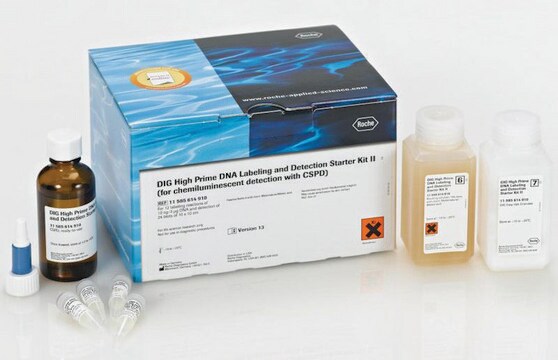11585606910
Roche
DIG-High Prime
sufficient for 40 labeling reactions, pkg of 160 μL, solution
Sinonimo/i:
DIG system
About This Item
Prodotti consigliati
Forma fisica
solution
Livello qualitativo
impiego
sufficient for 40 labeling reactions
Confezionamento
pkg of 160 μL
Produttore/marchio commerciale
Roche
Caratteristiche più verdi
Designing Safer Chemicals
Learn more about the Principles of Green Chemistry.
sustainability
Greener Alternative Product
Categoria alternativa più verde
Temperatura di conservazione
−20°C
Descrizione generale
Specificità
Applicazioni
- in Southern blots
- in northern blots
- in dot/slot blots
- for screening of gene libraries
- in In situ hybridizations
Caratteristiche e vantaggi
- DNA amounts ranging from 10ng to 3μg in a standard reaction.
- DNA of different lengths ranging from small restriction fragments to λ or cosmid DNA.
- DNA, supercoiled or linearized.
- DNA in low melting-point agarose.
Labeling efficiency:
A standard labeling reaction with 1μg template yields 0.8μg newly synthesized digoxigenin-labeled DNA after 1 hour, and 2μg after a 20-hour incubation at +37°C.
Contents
5x concentrated random primer mix: 1U/ μl Klenow polymerase, labeling grade, 1mM dATP, 1mM dCTP, 1mM dGTP, 0.65mM dTTP, 0.35mM DIG-11-dUTP, alkali labile in 50% (v/v) glycerol.
Qualità
In a standard assay with 1μg linearized pBR 328, 0.8μg of DIG-labeled DNA is synthesized after 1 hour, and 2.3μg after 20 hours. When this labeled DNA is used for hybridization at a concentration of 20ng/ml, 0.03pg homologous DNA are detected by chemiluminescence with the anti-DIG-alkaline phosphatase conjugate and CSPD on a dot or Southern blot.
Principio
Nota sulla preparazione
Assay Time: 80 minutes
Sample Materials
- DNA fragments of at least 100bp
- Linearized plasmid, cosmid or λDNA
- Supercoiled DNA
- Or minimal amounts of DNA (10ng), e.g., DNA restriction fragments isolated from gels or in molten agarose
Note: To obtain optimal results, template DNA should be linearized and should have a size of = 100bp or larger. Template DNA > 5kb should be restriction-digested using a 4bp cutter prior to labeling.
Altre note
Codice della classe di stoccaggio
12 - Non Combustible Liquids
Classe di pericolosità dell'acqua (WGK)
WGK 1
Punto d’infiammabilità (°F)
No data available
Punto d’infiammabilità (°C)
No data available
Certificati d'analisi (COA)
Cerca il Certificati d'analisi (COA) digitando il numero di lotto/batch corrispondente. I numeri di lotto o di batch sono stampati sull'etichetta dei prodotti dopo la parola ‘Lotto’ o ‘Batch’.
Possiedi già questo prodotto?
I documenti relativi ai prodotti acquistati recentemente sono disponibili nell’Archivio dei documenti.
I clienti hanno visto anche
Articoli
Digoxigenin (DIG) labeling methods and kits for DNA and RNA DIG probes, random primed DNA labeling, nick translation labeling, 5’ and 3’ oligonucleotide end-labeling.
Il team dei nostri ricercatori vanta grande esperienza in tutte le aree della ricerca quali Life Science, scienza dei materiali, sintesi chimica, cromatografia, discipline analitiche, ecc..
Contatta l'Assistenza Tecnica.






![CSPD ready-to-use Disodium 3-(4-methoxyspiro {1,2-dioxetane-3,2′-(5′-chloro)tricyclo [3.3.1.13,7]decan}-4-yl)phenyl phosphate](/deepweb/assets/sigmaaldrich/product/images/352/091/ef743cea-ccd8-44f1-8f3b-dec5a1e4f5d1/640/ef743cea-ccd8-44f1-8f3b-dec5a1e4f5d1.jpg)
